Let's see the glimpse below,
- Introduction
- Overview of Procurement Challenges
- The Need for Transformation
- Understanding Predictive Analytics in Procurement
- The Role of Automation in Procurement Forecasting
- Integrating Predictive Analytics and Automation
- Real-World Applications
- Best Practices for Integration
- Key Benefits of Predictive Analytics and Automation in Procurement Forecasting
- Overcoming Barriers to Implementation
- Future Trends in Procurement
- Optimizing Procurement with Yoroflow
- Concluding thoughts
Introduction
In an increasingly dynamic and interconnected global market, the role of procurement is more crucial than ever. Procurement teams face mounting pressures to ensure that businesses have the right goods and services at the right time, while also managing costs, mitigating risks, and ensuring supply chain resilience. As organizations strive to meet these demands, procurement forecasting has emerged as a key challenge. Traditional forecasting methods often fall short, leading to stockouts, overstocking, and inefficiencies that can significantly impact business performance.
The advent of predictive analytics and automation is transforming procurement forecasting, offering powerful solutions to these challenges. By harnessing the power of data-driven insights and automating manual processes, businesses can not only improve the accuracy of their forecasts but also enhance operational efficiency, reduce costs, and better align procurement strategies with overall business goals.
Overview of Procurement Challenges
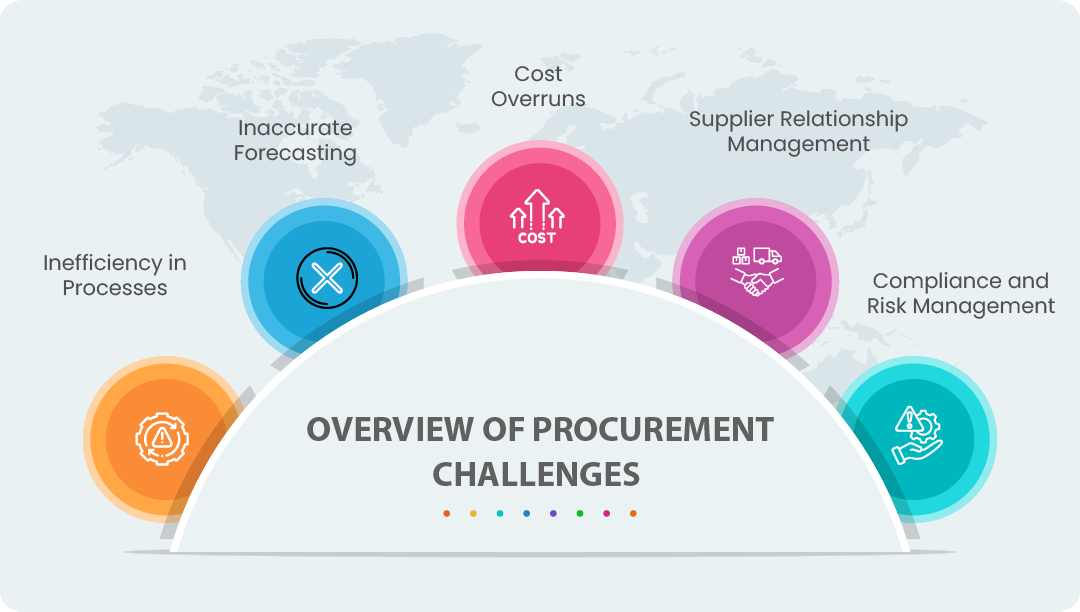
Procurement teams today face a myriad of challenges that hinder efficiency, accuracy, and overall performance. Some of the most pressing issues include:
- Inefficiency in Processes: Manual procurement processes, like handling purchase orders, supplier communications, and approvals, often involve repetitive tasks that can be prone to errors. These inefficiencies not only slow down operations but also increase the risk of bottlenecks and delays.
- Inaccurate Forecasting: Procurement relies heavily on forecasting to predict demand and plan purchases accordingly. However, inaccurate forecasting—whether due to outdated data, lack of real-time insights, or human error—can lead to stockouts or excess inventory. Both situations can disrupt operations and incur unnecessary costs.
- Cost Overruns: Without an efficient procurement strategy, businesses are at risk of overspending on supplies and services. This may happen due to lack of visibility into vendor performance, unfavorable contract terms, or poor demand planning. Cost overruns can significantly affect the bottom line, especially in industries where margins are tight.
- Supplier Relationship Management: Maintaining good relationships with suppliers is essential for procurement, but many teams struggle with inconsistent communication, delayed responses, and lack of transparency in performance tracking. These issues can cause friction, delays in deliveries, and missed opportunities for negotiation.
- Compliance and Risk Management: Ensuring procurement processes align with industry regulations, corporate policies, and ethical standards is a constant challenge. Manual checks and the inability to track compliance in real-time can expose organizations to legal and financial risks.
The Need for Transformation
Traditional procurement methods, often reliant on spreadsheets, paper trails, and manual decision-making, are no longer adequate to meet the demands of today’s fast-paced business environment. In an age where the speed of transactions and access to data has accelerated, the risks of inefficiency, inaccuracies, and overspending have grown significantly. Some of the reasons why traditional procurement methods are no longer enough include:
- Data Overload: With an overwhelming amount of data generated every day, it’s impossible for procurement teams to manually sift through information and make informed decisions quickly.
- Speed and Agility: Business needs to evolve rapidly, and procurement must keep pace. Legacy systems lack the agility required to adapt to fluctuating market conditions, fast demand shifts, and global supply chain disruptions.
- Globalization and Complexity: As businesses expand globally, procurement processes have become more complex. Sourcing from diverse suppliers, managing international logistics, and adhering to global standards have all become far too complicated for manual processes.
- Cost and Resource Constraints: With shrinking margins and increasing competition, procurement departments are under pressure to deliver more value with fewer resources. Traditional methods no longer provide the efficiency required to drive savings and reduce overheads.
Understanding Predictive Analytics in Procurement
In today's dynamic and fast-paced business environment, procurement teams need to make timely and informed decisions to manage supply chains effectively, reduce costs, and meet demand. Predictive analytics plays a critical role in transforming procurement by leveraging data-driven insights to predict future needs, trends, and potential risks. This technology enables businesses to anticipate demand, optimize inventory, and improve supplier relationships.
What are Predictive Analytics?
Predictive analytics leverages historical data, statistical algorithms, and AI to forecast outcomes in procurement, such as demand, price trends, and disruptions. Machine learning enhances predictions by analyzing data patterns and adapting to new information, while AI optimizes strategies, automates tasks, and recommends actions. Together, they enable smarter decisions, cost savings, and supply chain resilience.
How Predictive Analytics Works
The process of predictive analytics in procurement follows several key steps, each designed to gather and analyze data, produce insights, and forecast future procurement needs:
- Data Collection: Combines internal data (purchase history, inventory, supplier performance) with external sources (market trends, economic indicators) for improved forecasting.
- Data Cleaning & Preprocessing: Handles missing values, corrects errors, and normalizes data to ensure consistency and reliable insights.
- Data Analysis & Modeling: Uses predictive models (regression, decision trees, neural networks) to identify patterns and relationships between variables like demand fluctuations and supplier lead times.
- Forecasting & Prediction: Generates granular forecasts estimating future procurement needs, including inventory requirements, demand spikes, price changes, and supply chain risks.
- Actionable Insights: Provides foresight into future procurement needs, enabling proactive decision-making in purchasing, supplier negotiations, and inventory management.
- Continuous Learning & Improvement: Refines models with new data to ensure real-time strategy adjustments and improve forecasting accuracy.
The Role of Automation in Procurement Forecasting
In an increasingly complex and fast-paced business environment, procurement teams are tasked with managing large amounts of data and making decisions that can significantly impact a company’s bottom line. Procurement automation has emerged as a game-changing solution to streamline processes, reduce manual errors, and enhance forecasting accuracy. By integrating automation into procurement, organizations can optimize decision-making, improve efficiency, and better align their procurement strategies with organizational goals.
What is Procurement Automation?
Procurement automation uses technology to streamline tasks like order processing, supplier communication, invoicing, and payment. It reduces manual effort, enhances efficiency, and improves decision-making. By automating workflows, teams save time, minimize errors, ensure compliance, and focus on strategic activities like cost optimization and supplier management.
How Automation Improves Forecasting
Procurement forecasting requires accurate, timely, and reliable data to predict future demand, identify potential supply chain risks, and make informed purchasing decisions. Traditionally, procurement forecasting involved manual data entry, spreadsheet calculations, and guesswork, which were prone to human errors and inefficiencies. However, the integration of automation enhances forecasting accuracy in several key ways:
- Real-Time Data Analysis: Analyzes data in real time, using algorithms and machine learning to detect patterns, trends, and anomalies, allowing dynamic adjustments to forecasts.
- Predictive Analytics Integration: Combines automation with predictive analytics to generate highly accurate demand forecasts, accounting for historical trends, seasonal variations, and external factors.
- Enhanced Reporting & Dashboards: Customizable dashboards and reporting tools provide real-time insights into key procurement metrics like order accuracy, lead times, and supplier performance.
- Continuous Improvement: Machine learning enables automated systems to refine forecasting accuracy over time, adapting to changing conditions and improving decision-making.
Key Automation Technologies for Procurement Forecasting
Several automation technologies are transforming procurement forecasting, making it more efficient, accurate, and agile. Here are some of the key tools used in modern procurement automation:
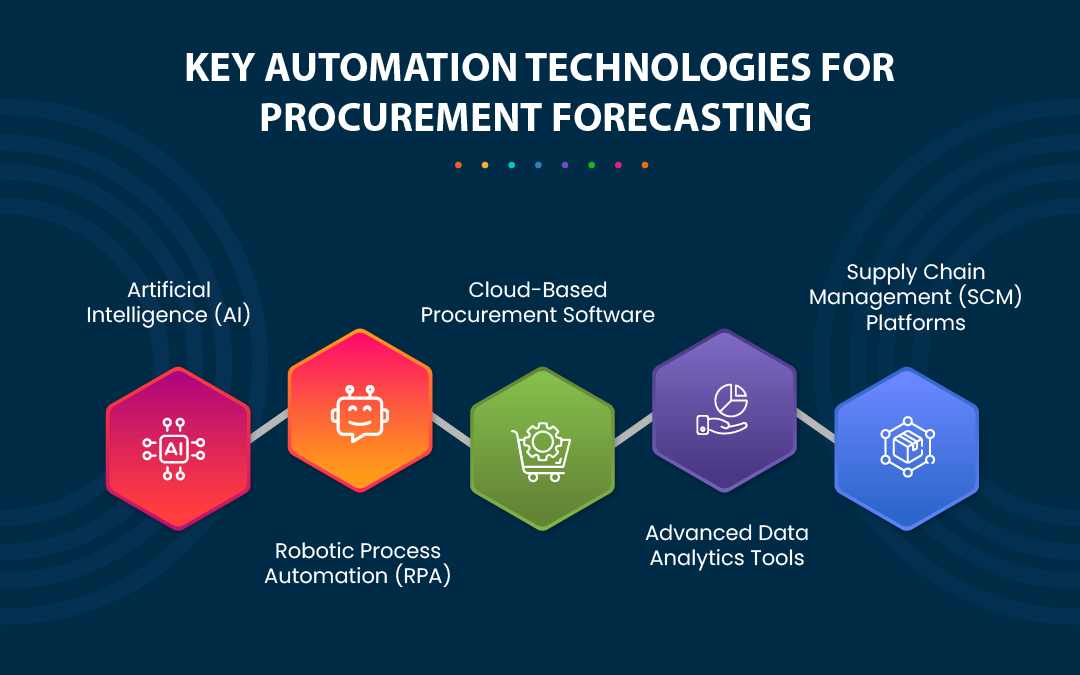
Artificial Intelligence (AI):
AI enhances procurement forecasting by analyzing large data sets, recognizing patterns, and predicting future outcomes. AI automates tasks like demand forecasting, supplier selection, and risk management by processing real-time data. AI-driven insights help identify the best suppliers based on past performance and suggest optimal purchasing schedules, aiding smarter decision-making in procurement.
Robotic Process Automation (RPA):
RPA uses software robots to automate repetitive tasks such as data entry, invoice processing, order tracking, and document management. By streamlining the collection and organization of procurement data, RPA ensures accuracy and timeliness. It also automates the generation of reports and updates forecasts based on real-time data, alerting teams to changes in demand or supplier performance.
Cloud-Based Procurement Software:
Cloud platforms offer centralized access to real-time data, market trends, and external insights, improving forecasting accuracy. They enable collaboration with suppliers and facilitate data-driven decisions. Many cloud-based tools integrate predictive analytics and AI to automate demand forecasts and adjust procurement strategies in real time, providing flexibility and efficiency.
Advanced Data Analytics Tools:
These tools enable procurement teams to mine large datasets using machine learning, statistical analysis, and predictive modeling. By analyzing historical data, sales trends, and supplier performance, data analytics platforms predict future procurement needs, offering valuable insights and supporting data-driven decision-making.
Supply Chain Management (SCM) Platforms:
Modern SCM platforms integrate procurement with supply chain operations, providing end-to-end visibility and automated decision-making. They include predictive analytics to forecast procurement needs, monitor inventory, and track supplier performance. These platforms improve supply chain efficiency by connecting procurement with logistics and inventory management.
Integrating Predictive Analytics and Automation
Integrating predictive analytics with automation in procurement offers a powerful combination for improving forecasting, risk mitigation, and supplier management. Predictive analytics uses historical data, market trends, and external variables to forecast future procurement needs, while automation ensures that these forecasts are executed efficiently. Integration allows businesses to forecast demand accurately, mitigate risks by anticipating supply chain disruptions, and automate routine procurement tasks.
For example, predictive analytics can forecast future demand spikes or supply chain interruptions, and automation can trigger corrective actions such as placing orders with suppliers, adjusting inventory levels, or reallocating resources in response to these forecasts. This synergy removes the need for manual decision-making, significantly reduces human error, and enables procurement teams to be proactive rather than reactive in their decision-making. It also helps optimize supplier management by predicting supplier performance, lead times, and potential risks, allowing for better selection and negotiation with suppliers.
Real-World Applications
Several organizations have successfully implemented the combination of predictive analytics and automation to improve procurement processes. For instance:
- Global Manufacturing Company: A multinational manufacturing firm used predictive analytics to anticipate fluctuations in demand for raw materials based on historical consumption patterns and production schedules. By integrating this with their automated procurement system, the company was able to automatically trigger purchase orders when demand predictions reached a certain threshold, preventing both stockouts and overstocking. This automated system also adjusted orders in real-time based on updated demand forecasts, reducing lead times and improving supplier relations.
- E-commerce Retailer: An e-commerce company implemented predictive analytics to forecast demand for seasonal products. Once demand was predicted, their automated system adjusted purchasing levels and placed orders with suppliers ahead of peak seasons. The automated system also helped avoid stockouts by making real-time adjustments based on changing market conditions and sales velocity, ensuring a steady supply of high-demand products.
These examples highlight how businesses can leverage both technologies to streamline procurement, improve accuracy, and ensure that procurement decisions are data-driven and timely.
Best Practices for Integration
Successfully integrating predictive analytics and automation requires careful planning and implementation. Key steps for a seamless integration include:
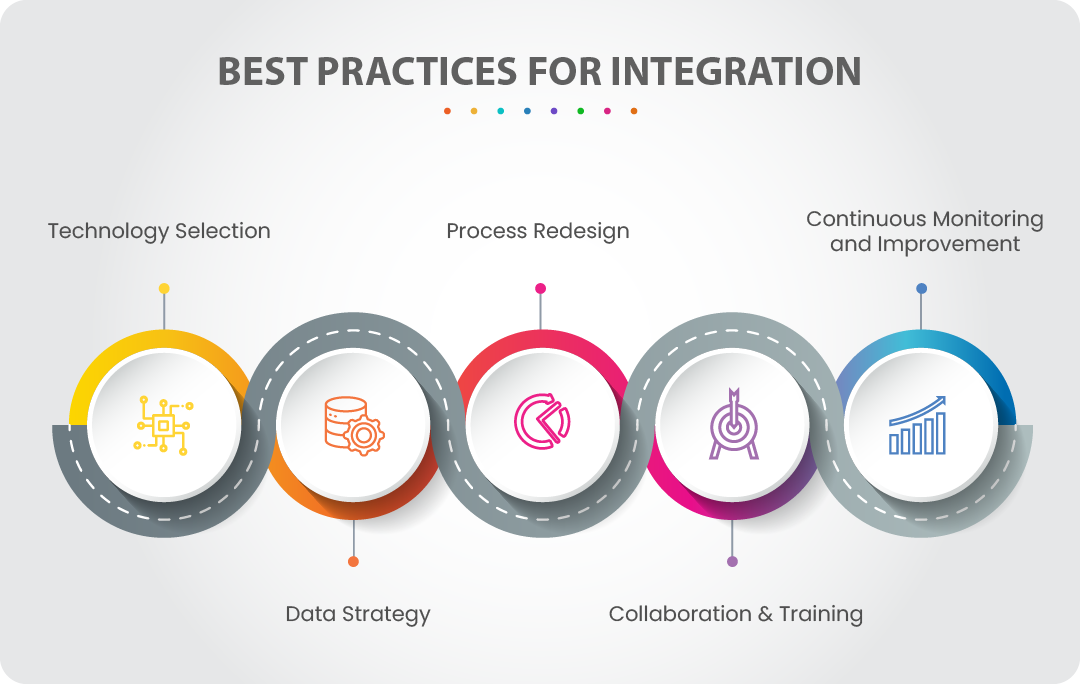
- Technology Selection: Choose the right tools that can integrate both predictive analytics and automation. This might involve selecting a procurement platform with built-in predictive capabilities or using separate best tools that can be integrated via APIs. Ensure that the selected tools are scalable, flexible, and capable of handling large volumes of data.
- Data Strategy: A strong data strategy involves collecting and integrating internal and external data, ensuring accuracy, preprocessing it for predictive models, and regularly updating to maintain optimal system performance.
- Process Redesign: Redesign procurement workflows to automate decision-making using predictive insights, such as triggering orders based on demand forecasts. Ensure processes handle real-time updates, allowing the system to adjust to new data and market conditions dynamically.
- Collaboration & Training: Successful integration requires collaboration between IT, procurement, and data analytics teams. Regular training should be provided to procurement teams to ensure they understand how the predictive models work and how to interact with the automated system effectively.
- Continuous Monitoring and Improvement: The integration process is not one-time but continuous. Regularly monitor system performance and predictive accuracy to ensure the tools are delivering value. Use feedback to adjust processes, fine-tune predictive models, and improve automation.
Key Benefits of Predictive Analytics and Automation in Procurement Forecasting
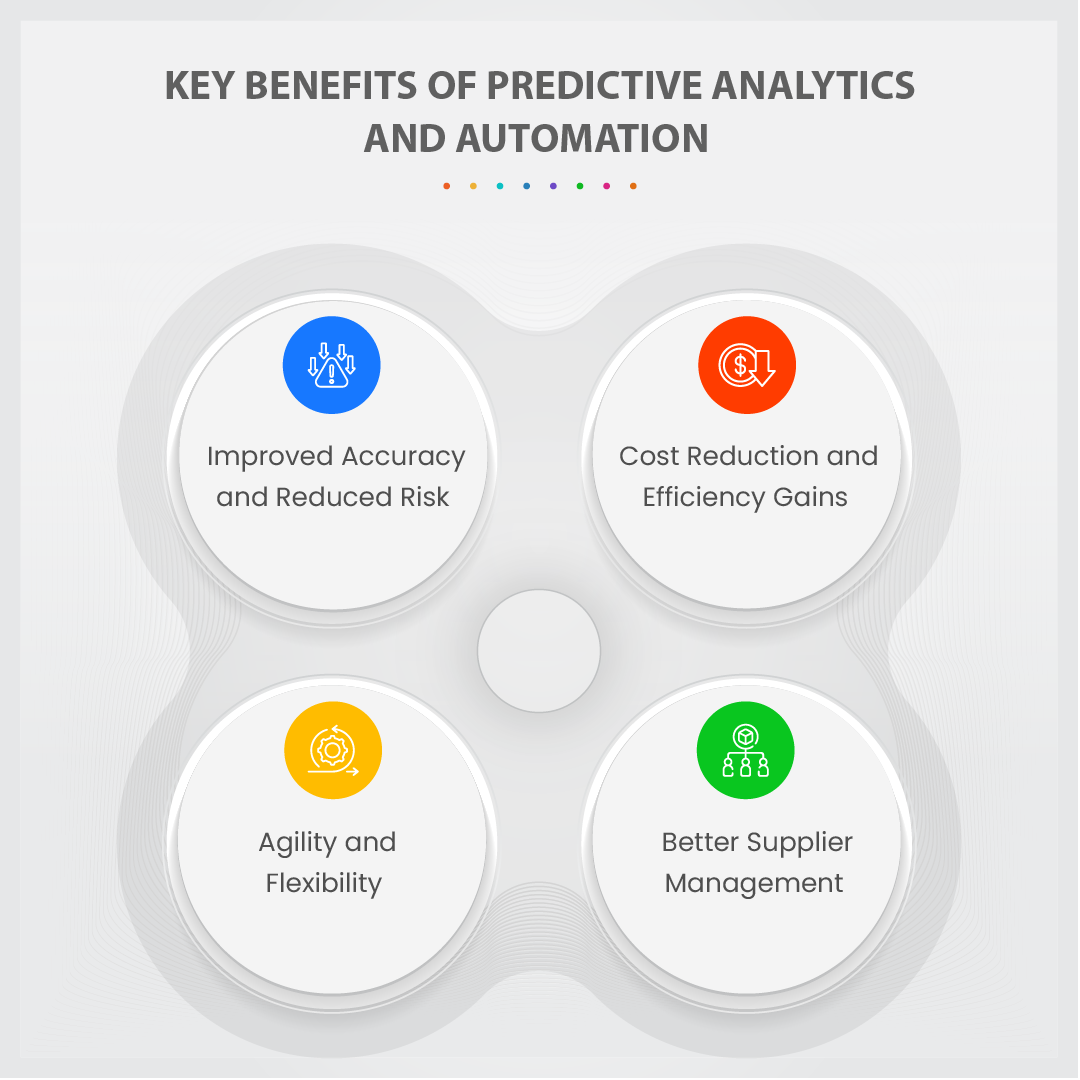
Improved Accuracy and Reduced Risk
Predictive analytics and automation minimize errors by relying on data-driven models, ensuring more accurate forecasting and reducing the risks of stockouts, overstocking, and poor supplier management.
Cost Reduction and Efficiency Gains
Automation streamlines repetitive tasks, reducing labor costs and optimizing inventory management. Predictive analytics ensures businesses only order what’s needed, cutting down on overstocking and reducing storage costs.
Agility and Flexibility
These technologies allow procurement teams to adapt quickly to market changes, demand fluctuations, and supply chain disruptions. Real-time adjustments to forecasts enable swift decision-making, maintaining continuity during disruptions.
Better Supplier Management
Accurate demand forecasting improves supplier relationships by enabling better negotiation, proactive order planning, and reliable supply chains. It also helps identify top-performing suppliers for more strategic partnerships.
Overcoming Barriers to Implementation
Challenges in Adopting Predictive Analytics and Automation
Data Quality Issues
Poor-quality data, such as incomplete or outdated records, can lead to incorrect forecasts and flawed decisions, limiting the effectiveness of predictive analytics and automation.
Resistance to Change
Employees may resist new technologies due to fear of job displacement or a lack of understanding of the benefits. Effective change management and clear communication are crucial to overcoming this.
Integration Complexity
Integrating new technologies with existing systems can be complex, especially with legacy systems. Careful planning, technical expertise, and infrastructure are required for seamless integration.
Strategies for Successful Implementation
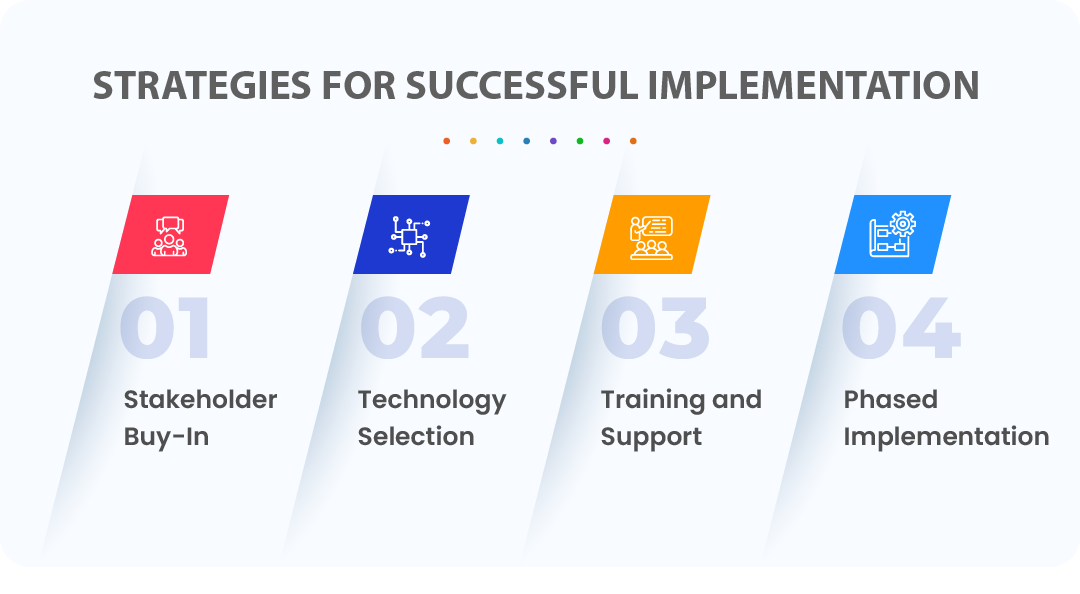
Stakeholder Buy-In
Securing buy-in from key stakeholders is vital for successful implementation. Highlighting the benefits of predictive analytics and automation, such as improved accuracy and cost savings, aligns all departments with the goals. Involving stakeholders early ensures effective support and resource allocation.
Technology Selection
Choosing the right tools is essential. Companies should select predictive analytics and automation platforms that integrate with existing systems, assessing scalability, flexibility, and ease of use to meet both current and future needs.
Training and Support
Training programs are crucial to help employees adapt to new tools, maximizing the benefits. Ongoing training and technical support maintain business continuity during the transition.
Phased Implementation
A phased approach allows businesses to test and refine integration gradually, minimizing disruptions and addressing challenges as they arise for smoother adoption.
Future Trends in Procurement
The Rise of AI and Machine Learning
AI and Machine Learning are transforming procurement by enhancing predictive models, processing large data sets, and automating decision-making. AI improves forecasting accuracy, optimizes inventory, and streamlines supplier selection, while machine learning refines predictions over time. These technologies enable automated responses to demand changes and market conditions, reducing costs and improving procurement efficiency.
Evolution of Supply Chain Visibility
The future of supply chain visibility will see near-real-time insights through IoT, sensors, and cloud-based platforms. This transparency enables better forecasting, improved supplier management, and proactive risk mitigation. Real-time data sharing will optimize procurement strategies, particularly in industries relying on just-in-time inventory.
Blockchain and Procurement
Blockchain offers secure, transparent transaction records, enhancing procurement automation. Smart contracts and reliable data tracking improve efficiency, reduce fraud, and optimize forecasting. Blockchain enables transparent supply chain tracking and automates transactions, reducing manual intervention and improving supplier relationships.
Optimizing Procurement with Yoroflow
Yoroflow offers a range of features to streamline and optimize procurement processes through automation, predictive analytics, and AI-driven decision-making. Here's how Yoroflow enhances procurement:
1. Automated Procurement Workflows
Yoroflow automates repetitive procurement tasks like order creation, approval workflows, and invoicing, reducing manual intervention and speeding up processes.
2. Predictive Analytics for Demand Forecasting
By leveraging predictive analytics, Yoroflow forecasts future procurement needs based on historical data, seasonal trends, and market conditions, improving inventory management and reducing stockouts or overstocking.
3. AI-Driven Supplier Selection
Yoroflow uses AI to analyze supplier performance data, helping procurement teams select the best suppliers based on factors like reliability, cost, and delivery time.
4. Streamlined Approvals and Compliance
Automated workflows ensure that procurement approvals are processed efficiently, and compliance requirements are met, reducing errors and delays.
5. Real-Time Reporting and Analytics
With customizable dashboards, Yoroflow provides real-time insights into procurement performance, supplier performance, inventory levels, and other KPIs, empowering procurement teams to make informed decisions.
6. Cost Optimization
By automating procurement tasks and optimizing supplier relationships, Yoroflow helps reduce costs and improve overall procurement efficiency.
7. Risk Management
Yoroflow integrates with risk management systems to identify potential risks in the supply chain, such as supplier delays or market fluctuations, allowing businesses to take proactive measures.
These features make Yoroflow an essential tool for transforming procurement processes, enhancing efficiency, and reducing costs while ensuring better decision-making and improved supplier relationships.
Concluding thoughts
Efficient procurement is critical for the success of any organization, and the integration of automation, predictive analytics, and AI has redefined how businesses approach this essential function. By streamlining workflows, optimizing supplier selection, and enabling real-time data-driven decisions, organizations can unlock significant cost savings, enhance operational efficiency, and mitigate risks.
Yoroflow is at the forefront of this transformation, offering an intuitive, powerful platform tailored to modern procurement needs. Whether it's automating routine tasks, improving forecasting accuracy, or providing actionable insights through real-time dashboards, Yoroflow empowers businesses to stay ahead in a competitive market.
Ready to revolutionize your procurement processes? Partner with Yoroflow today and take the first step toward a smarter, faster, and more efficient future.